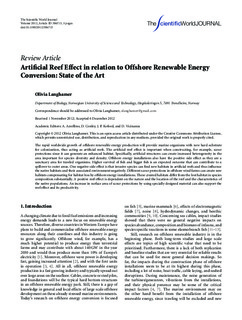| dc.contributor.author | Langhamer, Olivia | |
| dc.date.accessioned | 2019-10-14T08:23:02Z | |
| dc.date.available | 2019-10-14T08:23:02Z | |
| dc.date.created | 2013-01-31T20:22:01Z | |
| dc.date.issued | 2012 | |
| dc.identifier.citation | Scientific World Journal. 2012, 2012 . | nb_NO |
| dc.identifier.issn | 1537-744X | |
| dc.identifier.uri | http://hdl.handle.net/11250/2621866 | |
| dc.description.abstract | The rapid worldwide growth of offshore renewable energy production will provide marine organisms with new hard substrate for colonization, thus acting as artificial reefs. The artificial reef effect is important when constructing, for example, scour protections since it can generate an enhanced habitat. Specifically, artificial structures can create increased heterogeneity in the area important for species diversity and density. Offshore energy installations also have the positive side effect as they are a sanctuary area for trawled organisms. Higher survival of fish and bigger fish is an expected outcome that can contribute to a spillover to outer areas. One negative side effect is that invasive species can find new habitats in artificial reefs and thus influence the native habitats and their associated environment negatively. Different scour protections in offshore wind farms can create new habitats compensating for habitat loss by offshore energy installations. These created habitats differ from the lost habitat in species composition substantially. A positive reef effect is dependent on the nature and the location of the reef and the characteristics of the native populations. An increase in surface area of scour protections by using specially designed material can also support the reef effect and its productivity. | nb_NO |
| dc.language.iso | eng | nb_NO |
| dc.publisher | Hindawi | nb_NO |
| dc.rights | Navngivelse 4.0 Internasjonal | * |
| dc.rights.uri | http://creativecommons.org/licenses/by/4.0/deed.no | * |
| dc.title | Artificial Reef Effect in relation to Offshore Renewable Energy Conversion: State of the Art | nb_NO |
| dc.type | Journal article | nb_NO |
| dc.type | Peer reviewed | nb_NO |
| dc.description.version | publishedVersion | nb_NO |
| dc.source.pagenumber | 8 | nb_NO |
| dc.source.volume | 2012 | nb_NO |
| dc.source.journal | Scientific World Journal | nb_NO |
| dc.identifier.doi | 10.1100/2012/386713 | |
| dc.identifier.cristin | 1004418 | |
| dc.description.localcode | © 2012 Olivia Langhamer. This is an open access article distributed under the Creative Commons Attribution License, which permits unrestricted use, distribution, and reproduction in any medium, provided the original work is properly cited. | nb_NO |
| cristin.unitcode | 194,66,10,0 | |
| cristin.unitname | Institutt for biologi | |
| cristin.ispublished | true | |
| cristin.fulltext | original | |
| cristin.qualitycode | 1 | |

